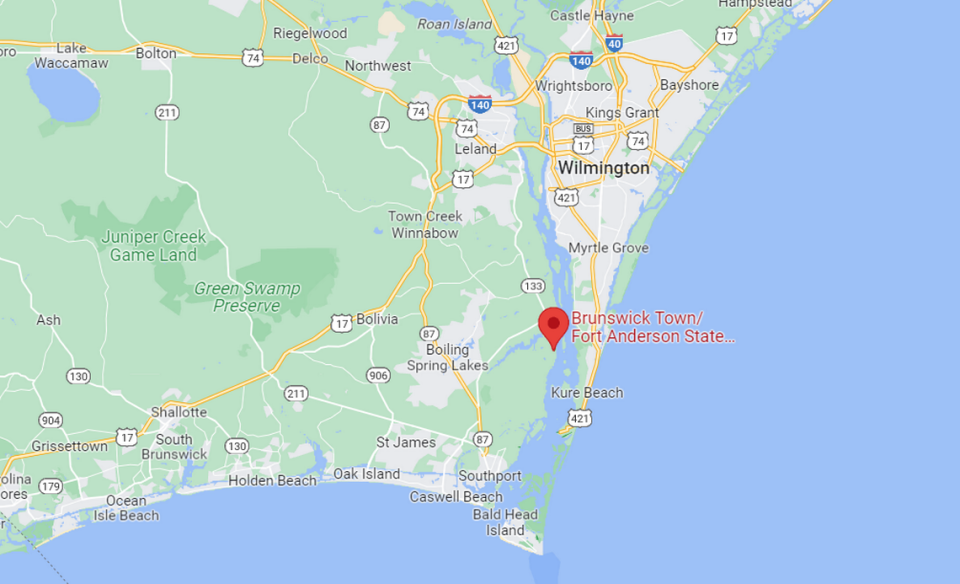Cannon found upright at bottom of NC river is older than initially believed, data says
A mysterious cannon found standing upright in North Carolina’s Cape Fear River has surprised historians by proving to be older than originally suspected.
The so-called Fortuna cannon — named for the ship that likely carried it — may date to 1660, according to Jim McKee, site manager of Brunswick Town/Fort Anderson State Historic Site in southeastern North Carolina.
That revelation was made after six years of electrolysis peeled away nearly two centuries of rust, grime and seashells.
What remains is a 3,000-pound weapon that historians continue to believe was used by the crew of the Spanish ship Fortuna, as it raided Brunswick Town in September 1748.
Conservation work has yet to find markings, McKee says, but countless other details have emerged, including what likely happened in those final chaotic minutes.
The cannon exploded in the face of gunners during the heat of battle, popping off a large chunk of the muzzle. It was then shoved off the deck into the river.
There it sat for about 268 years, until a dredging project funded by the U.S. Army Corps of Engineers struck the cannon on Dec. 21, 2016.
How did an English cannon from the 1660s end up on a Spanish ship in 1748?
McKee has a theory for that.
A complex history
Even without markings, the cannon has given up some of its secrets, McKee says.
Removing the grime has revealed it was cast between 1660 and 1710, fired eight-pound balls and likely served as a generic “merchant gun” for fighting off pirates and sea raiders.
It was not uncommon for obsolete cannons to end up in a “cannon depot” at ports like Havana, Cuba, where they could be carted out and put on merchant ships for a price, McKee says.
That explains how it may have ended up on a Spanish ship raiding British colonies like Brunswick Town, a “bustling shipping area for exporting tar, pitch, and turpentine.”
“Eight-pounder” cannons were known to work just as easily with 6-pound cannon balls, and that might have been the weapon’s undoing at Brunswick Town.
“You had to wrap up a 6-pound ball so it fits better in an eight-pounder, or it will bounce all the way down (the barrel),” he said.
“You can almost see the point of failure where muzzle burst. What might have done it was they fired a 6-pound ball that wasn’t properly wrapped and it got to end and found a weak spot and caused muzzle to burst.”
That explosion would have happened as the crew was firing at the militia in Brunswick Town, and it would have sent hot iron fragments flying. A gunner may have died in the process, McKee says.
What may never be known is who pushed it into the river.
The Fortuna ended up adrift in a militia counterattack and ran aground. Once that happened, the militia began picking the ship clean, even before the Spanish had abandoned ship, McKee says.
It’s possible the militia pushed it overboard, and the heaviest end of the gun was first to sink into the mud, leaving the cannon upright for hundreds of years.

Where is the Fortuna?
Gashes on the barrel show the cannon was hit by propellers on passing boats at least four times, so the dredging crew was not the first to encounter it, McKee says. However, the boaters likely never knew what they hit.
The 7.5-foot-long artifact was below the surface, with only half found sticking out of the mud, he says.
Despite its age and coincidental location, there remains no definitive proof the cannon was on the Fortuna, McKee says. But dredging work in the same area “cut into” what was believed to be a shipwreck near the river bank around 2018 — and that could offer the needed proof.
An East Carolina University archaeology project intends to search that area, and McKee believes the Fortuna may be found in the form of a football-shaped pile of ballast stones.
If anything, the cannon’s location has at least narrowed down where to look, he says.
“The discovery of the wreck will be the next big turning point,” McKee said. “That’s unless we find something written on the cannon. ... The whole history of Brunswick is like a 10,000 piece crossword puzzle ... and three quarters of the pieces are missing. This gun is a small piece of that puzzle.”
Conservation of the cannon is 90% complete, with waxing and preservation of the bore still to be done. Thanks to the mud that filled the cannon, the interior remains surprisingly clean, McKee said.
Once fully preserved, the cannon will be put on interior display at Brunswick Town.
Remnants of 18th-century tavern found spilling from hillside in NC farmer’s yard
Mysterious stone structures in North Carolina’s rivers linked to prehistoric people
WWII mystery turns 80: Torpedo-struck ship and its crew vanished off NC coast in 1942

